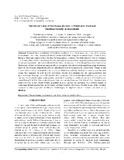| dc.contributor.author | Feyssa, Debela, Hunde | |
| dc.contributor.author | Njoka, J.T. | |
| dc.contributor.author | Asfaw, Z. | |
| dc.contributor.author | Nyangito, M.M. | |
| dc.date.accessioned | 2013-02-26T09:54:17Z | |
| dc.date.issued | 2012 | |
| dc.identifier.citation | Journal of Biological Sciences vol 12(5), 2012 | en |
| dc.identifier.issn | 1727-3048 | |
| dc.identifier.uri | http://erepository.uonbi.ac.ke:8080/xmlui/handle/123456789/11610 | |
| dc.description.abstract | Drylands have a multitude of livelihood problems where food insecurity is one of the serious impediments. Both transhumance and settled farmers make their living in the semiarid parts of east Shewa, Ethiopia. They adapt partly to food shortage by using natural resources. The study objective was to determine nutritional value of fruit of Berchemia discolor and analyse the use and management practices and associated indigenous knowledge. Data were collected from three study sites each in Fantalle and Boosat districts in East Shewa Zone. Before the laboratory analysis of fruit, the species was identified through focus group discussions and field observations. Mineral elements and phosphorus were determined in dry matter basis. Vitamin A and C were determined by spectrophotometer and redox titration respectively. Analysis of variance was done and means were separated by LSD at 0.05. Berchemia discolor is a candidate for dry land agroforestry and agrobiodiversity. Ten major uses of B. discolor (food, medicine, fuel wood and others) and food value were the highest. Total carbohydrates, crude protein, crude lipid, moisture and total ash contents of the fruit pulps ranged from 4.17-4.35%. The calculated energy from total carbohydrates was 314.50 kcal/100 g. Transhumance conserves Wild Edible Plants (WEPs) in pasture land and protect of vegetation, while settled farmers in traditional dryland agroforestry, in live fence and farm boarders. Berchemia discolor is one of the potential resources to enhance people’s livelihoods. Technologies for improved use and market chain need policy attention. | en |
| dc.language.iso | en | en |
| dc.publisher | Asian Network for Scientific Information | en |
| dc.subject | Climate change | en |
| dc.subject | Food security | en |
| dc.subject | Nutritional value | en |
| dc.subject | wild edible plants | en |
| dc.title | Nutritional Value of Berchemia discolor: A Potential to Food and Nutrition Security of Households | en |
| dc.type | Article | en |
| local.publisher | Department of Land Resource Management and Agricultural Technology, | en |

